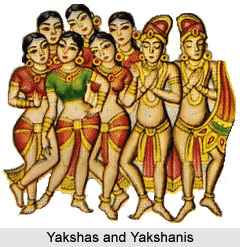 The Yakshas and Yaksinis are same as Jin, Arihant, or Tirthankaras who have been able to vanquish the inner passions. These deities are on the other hand full of passions and desires who wander through the cycles of births and death. They are also called shashandevtas, gaurdian deities. These deities are heavenly beings of Vyantar group who possess supernatural powers. They have the capability of changing their form and size. The following are the popular Yakshas and Yaksinis:
The Yakshas and Yaksinis are same as Jin, Arihant, or Tirthankaras who have been able to vanquish the inner passions. These deities are on the other hand full of passions and desires who wander through the cycles of births and death. They are also called shashandevtas, gaurdian deities. These deities are heavenly beings of Vyantar group who possess supernatural powers. They have the capability of changing their form and size. The following are the popular Yakshas and Yaksinis:
Chakreshware Devi: She is also known as Apratichakra. Chakreshware Devi is the dedicated attendant deity of Bhagwan Adinath, the first Jain Tirthankara who is also known as Bhagwan Rishabh Dev. The goddess is golden in colour. The eagle is her Vehicle and she has eight arms. In her four right hands she is seen holding the blessing mudra, arrow, rope and wheel. In her four left hands she holds the rein, the bow, the protective weapon of Indra and the wheel.
Ambika Devi: She is also known as Ambai Amba and Amra Kushmandini. Ambika Devi is the dedicated deity of Lord Neminath, the 22nd Jain Tirthankara. Her colour of the deity is golden and the lion is her vehicle. She has four arms. In her two right hands she holds a mango and in the other a branch of a mango tree. In her one left hand she is seen holding a rein and in the other she has her two sons.
Padmavati Devi: She is the dedicated deity of Lord Parshvanatha, the 23rd Jain Tirthankara. The colour of the goddess is golden and her vehicle is the snake with a cock`s head. She has four arms. In her two right hands she is seen holding a lotus and a rosary. The two left hands she holds a fruit and a rein.
Saraswati Devi: Goddess Saraswati is also known as the Goddess of knowledge. She is the source of all learning. This divine energy is the source of divine light. She is the remover of all ignorance. This deity is revered and worshipped by all faiths, worldly persons and saints. She has four arms, one holding a text, the other a rosary and two hands holding a musical instrument Veena. She is seated on a lotus and the swan peacock is her vehicle.
Lakshmi Devi: Goddess Lakshmi represents wealth. People worship her as the Goddess of wealth, power, money etc. her vehicle is owl. In the upper two hands, she is holding a lotus, in the lower right hand a rosary and in the lower left hand a pot.
Manibhadra Dev: Shri Manibhadra is originally a yaksha, who is worshipped by the Indian people from very ancient time. The introduction of worship of Manibhadra Dev in Jain worship is only a later adaptation. It is an image of six armed yaksha. The vehicle of this god is an elephant.
Ghantakarna Veer: This deity is worshipped by the Jains for protection and to get rid of all the evil influences that are created by lower types of negative energy. He is seen holding an arrow which is an indication of penetration of evil forces. The bow helps in giving forceful momentum to the arrow. His symbol is the bell that resounds to create propitious sounds in the atmosphere.
Nakoda Bhairava: This is the tutelary deity of Bhairava. This deity is usually found near the entrance of the temple. Devotees from far and near places visit the shrine. They make their offerings to the deity on fulfillment of their materialistic desires.
Bhomiyaji: The shape of this deity is that of a mountain. It is the natural positive energy of the mountain Sametshikharji. It is this energy that inspires and guides the believer and the traveller.




















